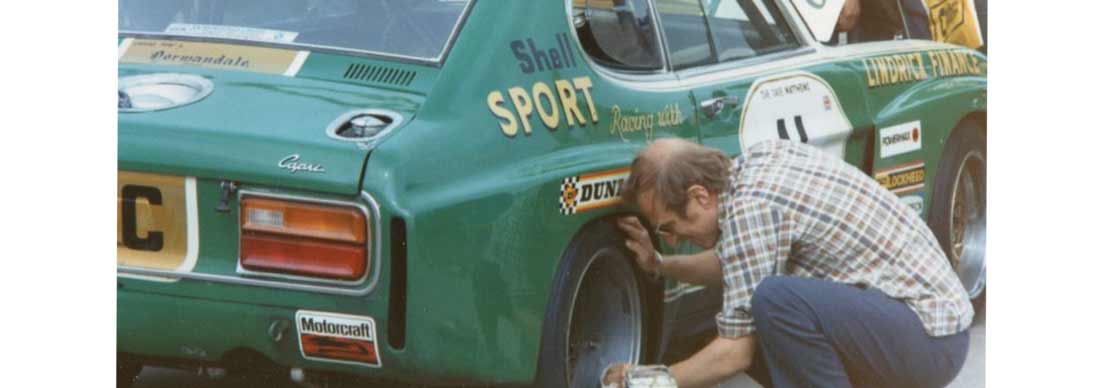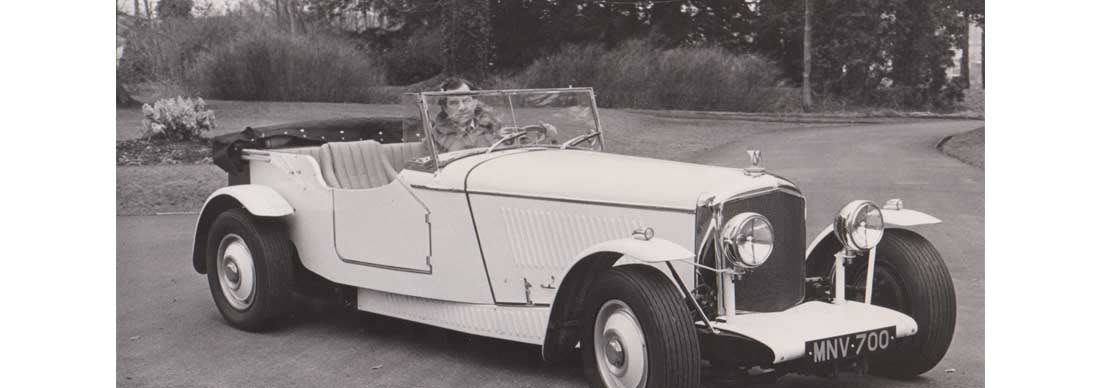
Ralph Broad, The Wizard of Brum - Part 2
During this time, a young Formula Ford driver called Andy Rouse asked Broad for an engine for his Dulon; he came away with both an engine and a job as a Broadspeed mechanic to pay for it. That quickly led to him racing in the Ford Mexico Championship, the Escort-based UK series, using a car he bought from Ralph’s Ford dealership at cost, and prepared by himself in the workshops. “I won the championship and Broadspeed did very well out of it, building cars to race in other countries,” remembers Rouse. “Suddenly the place was full of racing Mexicos!”
The 1972 racing season was looking bleak for Broadspeed with Ford, as the manufacturer had decided to concentrate on the Köln Capris. Broad accordingly sealed a deal with the British BMW importer to run a 3-litre CS Coupe in both UK and European races. It debuted at the Salzburgring, where Fitz finished 3rd to the two factory Köln Capris. This did not go down well with BMW's favoured tuners, Alpina and Schnitzer; on return to the UK, BMW UK withdrew its support, on orders from Munich.
So racing took a back seat while Broad concentrated on running his Ford dealership, although he did early development work on what would become the Bentley Mulsanne turbo in the 1980s, as well as consultancy work for Opel and TVR. For the latter he developed turbocharging of Ford’s V6 Essex engine, which was fitted in the TVR M series; it also went into the Broadspeed Bullit, a Mk 1 Capri which conversion the company offered.
Ford wanted a car that could win BSCC races outright and fight with the American cars at the longer circuits (multiple champion Camaro driver Frank Gardner was their target), but the European model range was limited. Zodiacs and Granadas were hardly sporting, so Broadspeed turned to the Capri, “which was about as suitable for racing as a Volkswagen Campervan”. The Capri’s handling was notoriously bad, so Broad put his thinking cap on and came up with a suspension system which would challenge not only rivals, but scrutineers too.

Broad applied out-of-the-box thinking to the suspension, to try to overcome the Capri’s tendency to throw itself off the road at high speeds. “The Group 2 touring car regulations were rather loosely written,” he said, “so I took a leaf out of The Railway Engineer’s Handbook, as they traditionally mount their suspension and springs outside the wheels. Car design has always dictated the reverse in an effort to stop the vehicle falling over.
“So I place the whole suspension at each corner of the car, so the springs and dampers now really have no effect. I use horizontal U-shaped rocker spring/damper units in the far corners of the car within the wheel arches. This overcomes dive and squat characteristics, and gives overall a well-balanced car. It is a complicated arrangement that is difficult to understand in metal, let alone explain on paper. Nowhere in the regulations are additional springs and dampers banned, so I’m rather looking forward to a confrontation with the scrutineers...” He won that one, which gave us the famous ‘Capri roll’ when one, often two wheels were waving in the air.
Jochen Neerspasch, who was about to leave Ford Köln for BMW, commissioned Broadspeed to build six complete Capri RS2600 body/chassis units, which would be raced in Europe during 1973. These were as far removed from the original road car as regulations would allow - flared wing panels, a ram airbox in the front hood to feed the 320bhp Weslake-prepared V6, and the totally revised suspension for the huge wheels. One thing he couldn’t do was fit a brace across the engine bay to stiffen the front end, as it would not clear the big intake trumpets of the V6. Development cost of the prototype was £25,000: $400,000 today.
Broad also ran a Capri RS2600 in the British Saloon Car Championship, driven by David Matthews, and another in Belgian events for Briton Vince Woodman. Both were effectively test-beds to feed updates into the Köln cars. Rouse shared Woodman’s car on occasion. “Ralph was brilliant, never short of ideas,” remembers Andy. “Sometimes they were just hard to put into practice, and they were usually drawn on the back of a cigarette packet…”
The Matthews car was destroyed in a three-car shunt at the 1973 British Grand Prix meeting at Silverstone, which involved Dave Brodie’s 3-litre Escort and Gavin Booth’s Mini. All three drivers were seriously injured and had to be cut from their cars, and Booth died from head injuries three weeks later.

Matthews, who had head and eye injuries, realises he was lucky to escape at all: “I owe my skin to the Broadspeed build qualities of that car. I’m not sure many people have got away with a bigger one than that. I thank that car for getting me out of it.”
Matthews’ son James would become the 1994 European and British Formula Renault champion; in 2017 he married Pippa Middleton, sister of the Duchess of Cambridge, Britain’s future queen.
The Capri RS2600 would have reliability issues in the longer Europe races – the Weslake V6 was particularly prone to breaking crankshafts - and netted one win only, Fitzpatrick sharing it with Dieter Glemser at the Salzburgring. “When BMW homologated bigger 3.5-litre engines and a giant rear wing mid-season, our Capris had no chance,” recalls Fitz. “I watched the BMWs disappear into the distance, and pondered what might have been...”
In motorsport, grudges rarely last for long, so in 1974 Broad was back in favour with his former bosses; BMC had now become British Leyland, and Ralph won the contract to run the works Triumph Dolomite Sprints.
With his magic touch and Andy Rouse at the wheel, the Broadspeed-prepared Dolomites earned the manufacturers' title for British Leyland, a much-needed boost for the strike-afflicted British government-owned company, which at its lowest level was churning out dreadful Morris Marinas and Austin Allegros
Broad believed that Jaguar, the flagship of the British Leyland group, should have an official racing presence again, and in 1975 he was given the contract to prepare the Jaguar XJ 5.3 V12 coupe for Group 2 of the BMW-dominated European Touring Car Championship. But this was always an unlikely racer, with its walnut dashboard and electric windows, and despite Broadspeed’s best efforts, they were overweight and unreliable.
John Davenport, who joined Leyland in December 1976 as director of motor sport, remembers, “Every problem was tackled by adding weight – bigger discs, calipers, pumps, uprights… I recall standing in the pits at a test day, with F1 designer Gordon Murray, who asked what the problem was. I said, it weighs 1680kg and we have to slow it for Stowe from 135mph. He said ‘Oh shit!’”
Even with Fitzpatrick (partnered with Tim Schenken), Rouse and Derek Bell on the driving strength, the Jaguars were never a match for the dominant BMW 3.0 CSL coupes, and failed to finish a single race. Broad believed that he could have made the Jaguars competitive had he been given another season to develop the cars. But the British Leyland money had run out, and the programme was axed amidst much embarrassment; the Jaguar XJ12C was a sad end to Ralph Broad’s otherwise near flawless career in motorsport.
Above: ATV Today footage 17.01.1966: Modified Mini. Gwyn Richards interview with Ralph Broad, the designer of the new Broadspeed GT Coupe, a modified Mini Cooper designed as a road car to run at up to 125mph. Image copyright MEDIA ARCHIVE OF CENTRAL ENGLAND (MACE).
Please note: by clicking the above photo to you will be able to view the footage on the MACE website (www.macearchive.org).
“BL management would listen to no one, but they were paying the bills so I had to agree with what they said, then I would go and do my own thing,” he told Motor Sport magazine years after the fiasco. “We could have beaten BMW given the time.”
Project engineer Roger King watched all this from the sidelines. “It was totally the wrong car to race, but Ralph was pushed into a corner. It should have been what Tom Walkinshaw had, an XJS – that would have been sensational. But Jaguar wanted to promote the V12. We were developing race by race. There just weren’t enough engines ready, and during European rounds the cars were away for ages. We had to repair them in the paddock.
The car was so unsuccessful, they decided it was doing Jaguar’s image no good, so they pulled the plug.”
Now the same trade unions which had crippled British Leyland got to work on Broadspeed. “I started when I was 14, and by the end I was employing 200 people,” he said. “But now the unions were telling me what to do. I didn’t do it, so they blackballed me. I said ‘that’s it,’ and in 1977 I sold out to former Mini racer John Handley. It lasted three years and then it closed.”
Broad retired to Portugal, where he ran a wood-burning stove business. He died in 2010. “A confident, easily-bored man with a self-deprecating sense of humour, Broad was a highly effective combination of driver, engineer and tuner”, was how he was described in his obituary.
But his legacy was the Minis, Anglias, Escorts, Capris and Dolomites which provided some of the best motor racing of the Sixties and Seventies, thrilling a generation of racegoers. Ralph Broad set standards of preparation which others could only hope to achieve, and very few did.
View other blog articles by Mark Cole
Books by Mark Cole






Leave a comment
This site is protected by hCaptcha and the hCaptcha Privacy Policy and Terms of Service apply.